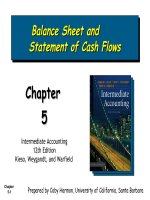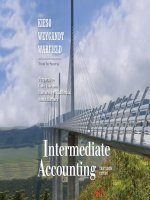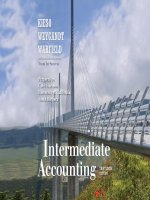Intermediate accounting 13th kieso warfield chapter 05
Bạn đang xem bản rút gọn của tài liệu. Xem và tải ngay bản đầy đủ của tài liệu tại đây (3.58 MB, 72 trang )
Chapter
5-1
CHAPTER
5
BALANCE SHEET AND
STATEMENT
OF CASH FLOWS
Intermediate Accounting
13th Edition
Kieso, Weygandt, and Warfield
Chapter
5-2
Learning
Learning Objectives
Objectives
1.
Explain the uses and limitations of a balance sheet.
2.
Identify the major classifications of the balance sheet.
3.
Prepare a classified balance sheet using the report and account
formats.
4.
Determine which balance sheet information requires supplemental
disclosure.
5.
Describe the major disclosure techniques for the balance sheet.
6.
Indicate the purpose of the statement of cash flows.
7.
Identify the content of the statement of cash flows.
8.
Prepare a statement of cash flows.
9.
Understand the usefulness of the statement of cash flows.
Chapter
5-3
Balance
Balance Sheet
Sheet and
and Statement
Statement of
of Cash
Cash Flows
Flows
Balance Sheet
Usefulness
Purpose
Limitations
Content and format
Classification
Preparation
Additional information
reported
Usefulness
Techniques of
disclosure
Chapter
5-4
Statement of Cash
Flows
Balance
Balance Sheet
Sheet
Usefulness of the Balance Sheet
Evaluating the capital structure.
Assess risk and future cash flows.
Analyze the company’s:
Chapter
5-5
Liquidity,
Solvency, and
Financial flexibility.
LO 1 Explain the uses and limitations of a balance sheet.
Balance
Balance Sheet
Sheet
Limitations of the Balance Sheet
Most assets and liabilities are reported at
historical cost.
Use of judgments and estimates.
Many items of financial value are omitted.
Chapter
5-6
LO 1 Explain the uses and limitations of a balance sheet.
Balance
Balance Sheet
Sheet
Classification in the Balance Sheet
Three General Classifications
Assets, Liabilities, and Stockholders’ Equity
Companies further divide these classifications:
Illustration 5-1
Chapter
5-7
LO 2 Identify the major classifications of the balance sheet.
Balance
Balance Sheet
Sheet
Current Assets
Cash and other assets a company expects to
convert into cash, sell, or consume either in one
year or in the operating cycle, whichever is longer.
Illustration 5-2
Chapter
5-8
LO 2 Identify the major classifications of the balance sheet.
Balance
Balance Sheet
Sheet
Review
The correct order to present current assets is
a. Cash, accounts receivable, prepaid items,
inventories.
b. Cash, accounts receivable, inventories, prepaid
items.
c.
Cash, inventories, accounts receivable, prepaid
items.
d. Cash, inventories, prepaid items, accounts
receivable.
Chapter
5-9
LO 2 Identify the major classifications of the balance sheet.
Balance
Balance Sheet
Sheet –– “Current
“Current Assets”
Assets”
Cash
Generally any monies available “on demand.”
Cash equivalents - short-term highly liquid
investments that mature within three months or less.
Restrictions or commitments must be disclosed.
Illustration 5-3
Chapter
5-10
LO 2 Identify the major classifications of the balance sheet.
Balance
Balance Sheet
Sheet –– “Current
“Current Assets”
Assets”
Short-Term Investments
Portfolios
Type
Valuation
Classification
Held-toMaturity
Debt
Amortized
Cost
Current or
Noncurrent
Trading
Debt or Equity
Fair Value
Current
Availablefor-Sale
Debt or Equity
Fair Value
Current or
Noncurrent
Chapter
5-11
LO 2 Identify the major classifications of the balance sheet.
Balance
Balance Sheet
Sheet –– “Current
“Current Assets”
Assets”
Short-Term Investments
Chapter
5-12
Illustration 5-5
Balance Sheet Presentation
of Investments in Securities
LO 2 Identify the major classifications of the balance sheet.
Balance
Balance Sheet
Sheet –– “Current
“Current Assets”
Assets”
Receivables
Claims held against customers and others for money,
goods, or services.
Accounts receivable – oral promises
Notes receivable – written promises
Major categories of receivables should be shown in the
balance sheet or the related notes.
Chapter
5-13
LO 2 Identify the major classifications of the balance sheet.
Balance
Balance Sheet
Sheet –– “Current
“Current Assets”
Assets”
Accounts Receivable – Presentation Options
11
22
Chapter
5-14
Current Assets:
Cash
Accounts receivable
Less allowance for doubtful accounts
Inventory
Total current assets
Current Assets:
Cash
Accounts receivable, net of $25 allowance
Inventory
Total current assets
$ 346
500
25
475
812
$1,633
$ 346
475
812
$1,633
LO 2 Identify the major classifications of the balance sheet.
Balance
Balance Sheet
Sheet –– “Current
“Current Assets”
Assets”
Receivables
Illustration 5-6
Balance Sheet Presentation
of Receivables
Chapter
5-15
LO 2 Identify the major classifications of the balance sheet.
Balance
Balance Sheet
Sheet –– “Current
“Current Assets”
Assets”
Inventories
Company discloses:
Basis of valuation (e.g., lower-of-cost-or-market).
Method of pricing (e.g., FIFO or LIFO).
Illustration 5-7
Chapter
5-16
LO 2 Identify the major classifications of the balance sheet.
Balance
Balance Sheet
Sheet –– “Current
“Current Assets”
Assets”
Prepaid Expenses
Payment of cash, that is recorded as an asset because
service or benefit will be received in the future.
Cash Payment
BEFORE
Expense Recorded
Prepayments often occur in regard to:
insurance
supplies
advertising
Chapter
5-17
rent
maintenance on equipment
LO 2 Identify the major classifications of the balance sheet.
Balance
Balance Sheet
Sheet –– “Current
“Current Assets”
Assets”
Prepaid Expenses
Illustration 5-9
Chapter
5-18
LO 2 Identify the major classifications of the balance sheet.
Balance
Balance Sheet
Sheet –– “Current
“Current Assets”
Assets”
Current Assets - “Summary”
Cash and other assets a
company expects to
convert into cash,
sell, or
consume
either in one year or in
the operating cycle,
whichever is longer.
Chapter
5-19
LO 2 Identify the major classifications of the balance sheet.
Balance
Balance Sheet
Sheet –– “Noncurrent
“Noncurrent Assets”
Assets”
Long-Term Investments
Generally consists of four types:
Securities
Fixed assets
Special funds
Nonconsolidated subsidiaries or affiliated
companies.
Chapter
5-20
LO 2 Identify the major classifications of the balance sheet.
Balance
Balance Sheet
Sheet –– “Noncurrent
“Noncurrent Assets”
Assets”
Long-Term
Investments
Securities
bonds,
stock, and
long-term notes
For marketable securities,
management’s intent
determines current or
noncurrent classification.
Chapter
5-21
Balance Sheet (in thousands)
Current assets
Cash
$ 285,000
Investments:
Invesment in ABC bonds
Investment in UC Inc.
Notes receivable
Land held for speculation
Sinking fund
Pension fund
Cash surrender value
Investment in Uncon. Sub.
Total investments
Property, Plant, and Equip.
Building
Land
321,657
253,980
150,000
550,000
225,000
653,798
84,321
457,836
2,696,592
1,375,778
975,000
LO 2 Identify the major classifications of the balance sheet.
Balance
Balance Sheet
Sheet –– “Noncurrent
“Noncurrent Assets”
Assets”
Long-Term
Investments
Balance Sheet (in thousands)
Current assets
Cash
$ 285,000
Investments:
Fixed
Fixed Assets
Assets
Land held for
speculation
Invesment in ABC bonds
Investment in UC Inc.
Notes receivable
Land held for speculation
Sinking fund
Pension fund
Cash surrender value
Investment in Uncon. Sub.
Total investments
Property, Plant, and Equip.
Building
Land
Chapter
5-22
321,657
253,980
150,000
550,000
225,000
653,798
84,321
457,836
2,696,592
1,375,778
975,000
LO 2 Identify the major classifications of the balance sheet.
Balance
Balance Sheet
Sheet –– “Noncurrent
“Noncurrent Assets”
Assets”
Long-Term
Investments
Balance Sheet (in thousands)
Current assets
Cash
$ 285,000
Investments:
Special Funds
Sinking fund
Pensions fund
Cash surrender
value of life
insurance
Chapter
5-23
Invesment in ABC bonds
Investment in UC Inc.
Notes receivable
Land held for speculation
Sinking fund
Pension fund
Cash surrender value
Investment in Uncon. Sub.
Total investments
Property, Plant, and Equip.
Building
Land
321,657
253,980
150,000
550,000
225,000
653,798
84,321
457,836
2,696,592
1,375,778
975,000
LO 2 Identify the major classifications of the balance sheet.
Balance
Balance Sheet
Sheet –– “Noncurrent
“Noncurrent Assets”
Assets”
Long-Term
Investments
Balance Sheet (in thousands)
Current assets
Cash
$ 285,000
Investments:
Nonconsolidated
Subsidiaries or
Affiliated
Companies
Chapter
5-24
Invesment in ABC bonds
Investment in UC Inc.
Notes receivable
Land held for speculation
Sinking fund
Pension fund
Cash surrender value
Investment in Uncon. Sub.
Total investments
Property, Plant, and Equip.
Building
Land
321,657
253,980
150,000
550,000
225,000
653,798
84,321
457,836
2,696,592
1,375,778
975,000
LO 2 Identify the major classifications of the balance sheet.
Balance
Balance Sheet
Sheet –– “Noncurrent
“Noncurrent Assets”
Assets”
Property, Plant, and
Equipment
Assets of a durable
nature used in the
regular operations
of the business.
Balance Sheet (in thousands)
Current assets
Cash
Total investments
Property, Plant, and Equip.
2,696,592
Building
Land
Machinery and equipment
Capital leases
Leasehold improvements
Accumulated depreciation
Total PP&E
Intangibles
1,375,778
975,000
234,958
384,650
175,000
(975,000)
2,170,386
Goodwill
Patents
Trademarks
Chapter
5-25
$ 285,000
3,000,000
177,000
40,000
LO 2 Identify the major classifications of the balance sheet.









